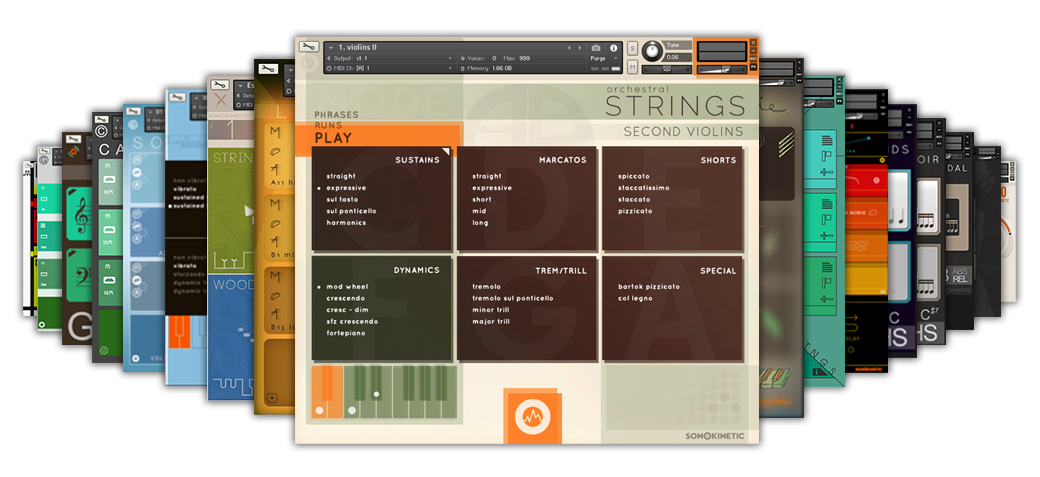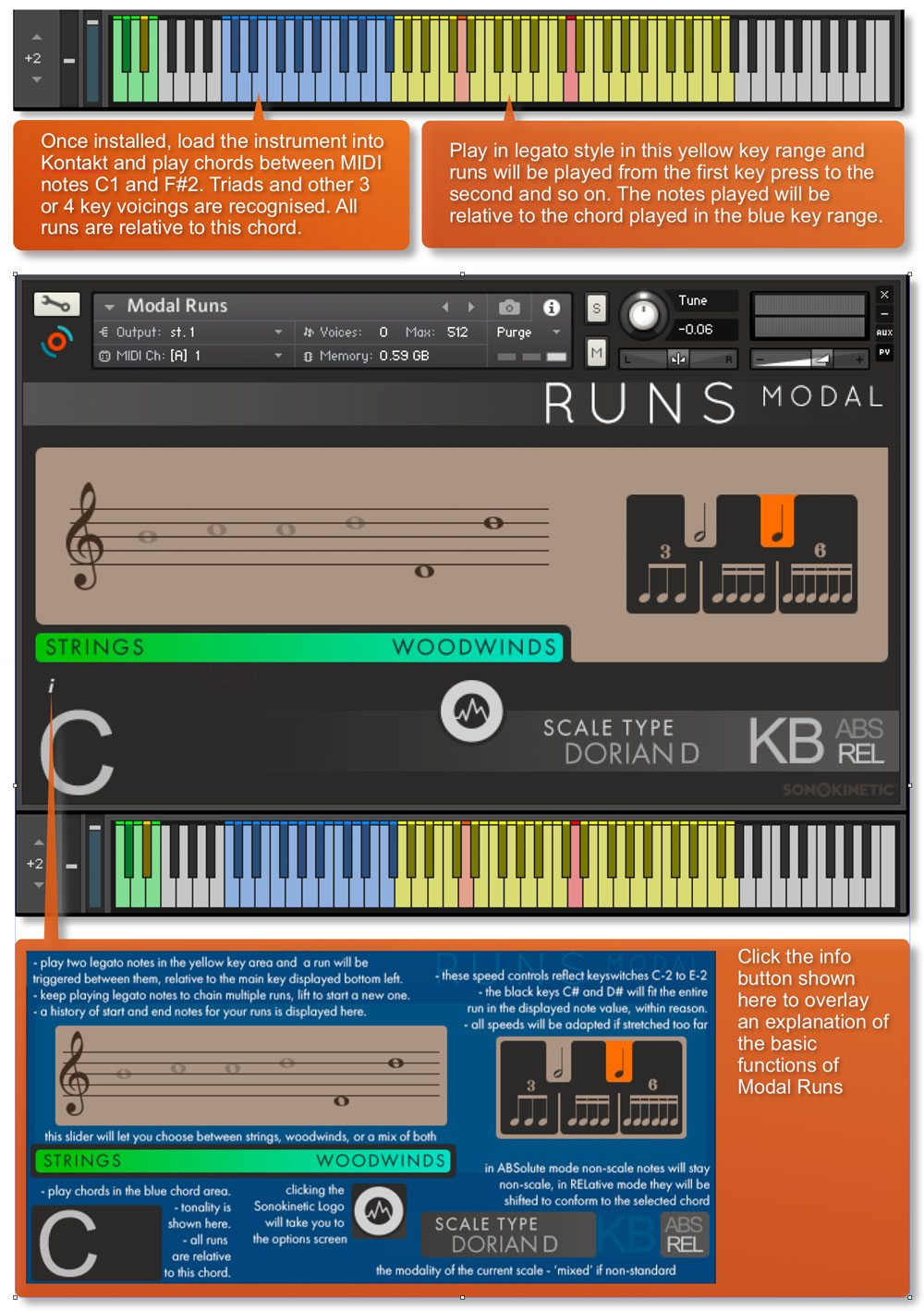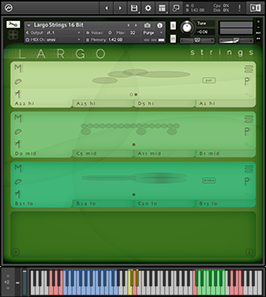Modal Runs
Content
44.1kHZ - 24 Bit
60 COMPLETE RUNS RECORDING SAMPLES
1GB NCW Format
Royalty and copyright free
content license
Format
FOR NATIVE INSTRUMENTS KOMPLETE KONTROL NKS 1.5>
Learn more about Native Instruments’ revolutionary new tools here
FOR NATIVE INSTRUMENTS KONTAKT AND KONTAKT PLAYER 5.8.1 and up.
Learn more about Kontakt and Kontakt Player here
Instrument Patches
Native Instruments Kontakt
Modal Runs
Custom designed interface with score display
Time Machine Pro capability
Custom chord recognition capabilities
Sampled Instruments
2 recorded orchestral sections
- Woodwind 8 players
- Strings 52 players
4 recorded microphone positions
- Close
- Decca tree
- Wide
- Balcony
Watch ‘Modal Runs’ in action
Learn from our videos & DEMOS
SONOKINETIC PROVIDES TUTORIALS AND VIDEO FEATURES TO HELP YOU GET ALL THE INFORMATION YOU NEED TO WORK WITH OUR TOOLS. EXPLORE OUR VIDEO CHANNELS FOR MORE IN-DEPTH INFORMATION ON OUR COMPOSING TOOLS.
TUTORIAL:
In Detail
DAW CAST
DAW CAST
DEMOS
About Modal Runs
The most intuitive runs instrument out there
Realistic runs are hard to produce with a conventional multisampled instrument, and fast runs are hard to play if you're not an accomplished pianist.
We produced this instrument to make fast runs extremely easy to play. They adapt to your composition's tempo and key, making completely realistic runs attainable for everybody.
Whether it be just a single run up to a transition, or an intense flurry of up and down runs that are the centerpiece of a composition, these runs will deliver. Play them with just a chord in the left hand and a beginning and end note in the right hand. They are great fun to play around with, and the intuitive 'emphasis' slider dials in a mix between the recorded strings and woodwinds sections in one fluid motion.
Note the 'Modal' part of the name - these runs don't just play from major scales root notes - they can start and end on any note of the scale, making all modalities within the diatonic scale available. Additionally, when in Relative Keyboard mode, any note you press on the right hand side will be conformed to the nearest scale tone, making it really easy to play runs that adapt to changing chords in real time!
With this new inventive and holistic approach to editing and scripting, we kept the sample count and RAM footprint extremely low for this instrument without compromising on the realism of the end result.
Returning to the superb recording space we employed for other Sonokinetic orchestral libraries, we gathered a selection of some of the greatest (and most precise) players to perform for us. With a full woodwind and string section at our disposal, we captured the full range of the instruments. Modal Runs is designed from the ground up, borrowing design aspects from our other instruments such as Ostinato. This script is an exciting new development that we are very proud of and stretches the limits of what you can achieve with traditional sampling.
This library coexists alongside both our Orchestral Series and our Phrase-Based libraries, being recorded in the same hall, with identical mic positions and even utilising some of the same players. Our orchestral libraries blend seamlessly together.
We, at Sonokinetic BV, are very proud to introduce Modal Runs to you and can’t wait to hear the amazing things you, our valued customer base, will produce with it.
Sonokinetic has established a name as one of the best value & quality sample producers and with this product we’d like to underline that statement. We stick with our unbeatable pricing module and high quality sampling.
Technical Overview
The Interface
Left is the main interface for Modal Runs. Almost every aspect of the instrument can be changed either by clicking on the appropriate part of the interface, or by using the colored keyswitches. There are also further options available by clicking the central Sonokinetic logo.
Emphasis Slider
The green / blue 'emphasis' slider in the centre of the interface allows mixing between the string and woodwind performances. MIDI CC11 is the default controller for this slider, so you can play it live with an expression pedal automatically. Right click to “learn midi” so the slider can be assigned to a MIDI controller for live mixing options. We have intentionally left off any markers so users are gently encouraged to use their ears to set the balance.

The default position is a 50/50 mix of strings and woods

Drag to the left for 100% strings (green)

Drag to the right for 100% woodwinds (blue)
Absolute & Relative Modes

At the bottom right of the interface are options for two different playback modes; Absolute (ABS) and Relative (REL).
Absolute mode means any note will be used as a start/end note, so you will get non-chord notes as start end notes in these cases.
Relative mode means any non-scale key you press (relative to the current selected chord) will be nudged towards a chord note and treated as such. You might like to think of this as “white key mode”, where you can just play any white key and it will trigger in-scale runs in whichever key you're in
MOD Wheel
By default the MOD wheel of your MIDI keyboard will control the output volume of all of the performances. As you lower the volume using the MOD wheel, subtle EQ adjustments are also introduced to soften the sound.
Speed Control
Regardless of the time signature and speed of your composition, the Modal Runs engine will adjust the timing and playback of the runs automatically so that they fit your project.

There are 5 different speeds you can set. Click the buttons shown here to change the playback speed of the performance, relative to your DAW’s BPM. The runs will always sync to your host DAW tempo, being time-stretched within Kontakt to match the BPM. You can also use the keyswitches from C0 to E0 to switch between playback speeds.
NOTE: The black rhythm keys (C#0 and D#0) will time your run to fit playback to a half note and a quarter note respectively, if that is within a reasonable amount of stretch for the amount of notes. If not, it will first go to triplets, then half or double.

Options
Click the Sonokinetic icon at the bottom of the interface to open the options menu. From here you can control microphone mixing and global tuning.

Tuning

It’s easy to change the global pitch within Modal Runs. Just click the +/- controls shown here. Choose from either standard pitch (440Hz) or an alternative concert pitch (436 - 444Hz). Some live orchestras may be tuned to these alternative pitches so this function makes it easy to match the samples in Modal Runs to live recordings.
Setting tuning to “off” can be used if you want to set up your own bespoke tuning and will ensure that Modal Runs will not reset to a particular frequency next time you open the instrument.
Microphone Mixing
The samples for Modal Runs have been recorded in the same hall as sister libraries; Largo, Noir, Woodwind Ensembles, Tutti Vox, Expressivo, Maximo, Sotto, Capriccio, Grosso, Minimal, Da Capo, Tutti, Maximo, Vivace, Indie and the Ostinato libraries. As such, Modal Runs has similar options for microphone mixing; Close, Decca Tree, Wide and Far (balcony). It is possible to use just one microphone position or mix between two different positions.

These different positions can be selected by clicking on the microphone position name.
Mixing is controlled by dragging the white slider line. The crossfade operates in such a way that the central position will play both microphone positions at full volume.
Microphone mixing options are global and apply to the entire instance of Modal Runs. Note that activating multiple microphone sections puts additional strain on CPU usage.

If you plan on using just one microphone position, set the other position to NONE to conserve CPU and RAM.
Playing Modal Runs
The basic method of playing Modal Runs is to firstly play three or four note chord combinations in the key range C1 to F#2. The chord recognition system will automatically detect inversions. Next, play in a legato style in the yellow key range from G2 to G5 to trigger string / woodwind runs. These runs will be played continuously as long as you continue to play in legato style with connected notes. To stop playback of the runs simply cease playing.

Recognised Chords
The engine recognises chords that adhere to a diatonic scale, being able to play runs in every modality. Shown below are the recognised types of chords, and their inversions. These are shown in C but of course you can transpose these to whichever root key you’d like to.
| major | (CEG ECG GCE) | |
| minor | (CEbG EbGC GCEb) | |
| half dimished | (CGbBb GbBbC BbCGb) | (CEbGbBb EbGbBbC GbBbCEb BbCEbGb) |
| dominant 7th | (CEBb EBbC BbCE) | (CEGBb EGBbC GBbCE BbCEG) |
| major 7th | (CEB EBC BCE) | (CEGB EGBC GBCE BCEG) |
| minor 7th | (CEbBb EbBbC BbCEb) | (CEbGBb EbGBbC GBbCEb BbCEbG) |
| sus4 | (CFG FGC GCF) | |
| 7sus4 | (CFGBb FGBbC GBbCF BbCFG) |
Visual Feedback
Whilst playing, you’ll see the interface show you which chord you’ve chosen, the scale type and the last 6 destination notes. All of this information is automatically displayed and it is purely for your own feedback, so you can see what the engine is doing. 'Composite' will be displayed when either the first or the last note of your run are outside of the scale (like starting a run in C on C#) when you are in ABS mode.

Managing CPU and RAM
Modal Runs can push Kontakt hard in terms of processing. Therefore, it’s useful to know how to limit the memory and processor impact within your own system. Although we’ve covered some of these aspects already, the following processes will help to conserve RAM and CPU:
- Use only one microphone position and set the other to NONE
Tips And Tricks
- Our phrase-based instruments work best when played live.
- All sliders can be set to their default position by holding cmd / control whilst left-clicking.
- You can right-click on any slider within Modal Runs to assign a MIDI CC controller. String / Woodwind mix is already set to MIDI CC11 by default but you can easily reassign it.
- Use the mod wheel to make Modal Runs sound more realistic, shaping the dynamics and adding depth to your performance.
- Ensure that Modal Runs is tuned to the rest of your instruments by using the Tuning control in the options screen.
- For onboard help, click the ‘i’ at the bottom left of the interface.
Support and Manual Download
A representative will follow-up with you as soon as possible,
typically within 48 hours of your request.
We often try to respond quicker than this,
but please note we are in a European time zone and Sonokinetic offices
and studios are opened on European business hours.
please follow: support.sonokinetic.net to submit your support ticket
DOWNLOAD
COLLECTION COMPLETER OPTIONS


31% OFF the ORCHESTRAL COLLECTION
A Selection of The Latest Orchestral Phrase Libraries.
BANG FOR YOUR BUCK!












